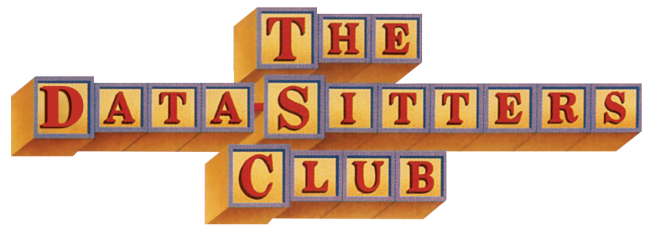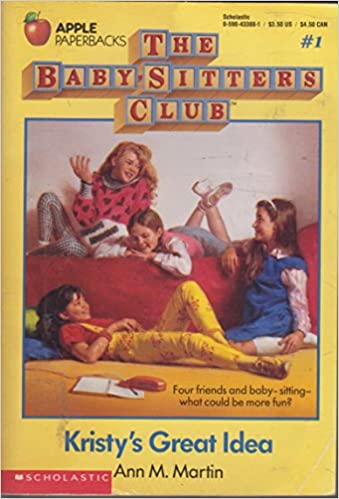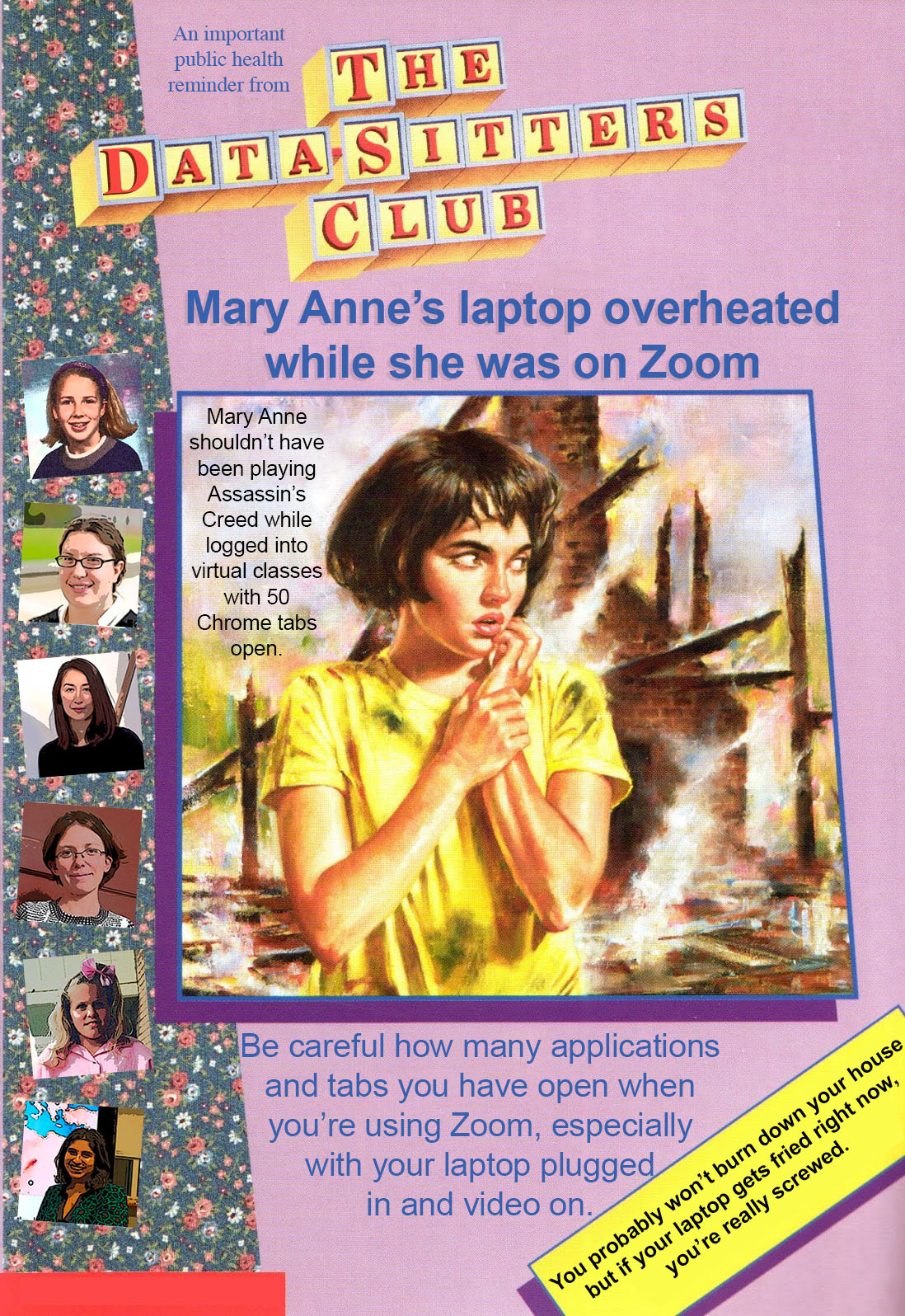You have /5 articles left.
Sign up for a free account or log in.

The Data-Sitters Club
Meet The Data-Sitters Club, a group of scholars who’ve come together to do computational text analysis of the enormously popular children’s book series they grew up reading: Ann M. Martin’s The Baby-Sitters Club, published in the 1980s and 1990s about a group of middle school girls in a fictional suburban Connecticut town who formed a successful babysitting business.
 Quinn Dombrowski is the Kristy Thomas of the group -- Kristy, for those not already in the know, being the character who conceived the Baby-Sitters Club, or BSC, and served as the club’s president. Dombrowski, an academic technology specialist at Stanford University’s Division of Literatures, Cultures and Languages, identifies as a Kristy, short in stature and long in leadership ability, except she lacks Kristy’s athletic skills. “Somewhat paradoxically, I’m the world’s least athletic Kristy,” she said. “I am short, and I take charge, but I only run if chased and I’m terrified of spheres of all sorts.” (She would not have distinguished herself as a player on Kristy’s Krushers, the children’s softball team Kristy coached. Or maybe she would have fit right in, given the Krushers' less-than-formidable athletic reputation.)
Quinn Dombrowski is the Kristy Thomas of the group -- Kristy, for those not already in the know, being the character who conceived the Baby-Sitters Club, or BSC, and served as the club’s president. Dombrowski, an academic technology specialist at Stanford University’s Division of Literatures, Cultures and Languages, identifies as a Kristy, short in stature and long in leadership ability, except she lacks Kristy’s athletic skills. “Somewhat paradoxically, I’m the world’s least athletic Kristy,” she said. “I am short, and I take charge, but I only run if chased and I’m terrified of spheres of all sorts.” (She would not have distinguished herself as a player on Kristy’s Krushers, the children’s softball team Kristy coached. Or maybe she would have fit right in, given the Krushers' less-than-formidable athletic reputation.)
In any case, Dombrowski came up with the idea for applying computational text analysis techniques to the BSC corpus. There are more than 200 BSC books and more than 176 million copies in print, and the series has spawned a movie, an ongoing graphic novel series and a forthcoming Netflix show.
“We’re thinking about what sorts of questions we could ask of all these books and analyze them in a way that would have been over our heads when we were reading them but can get to interesting questions about the cultural context in which the books were written, about the way gender roles were portrayed, the way race was portrayed,” Dombrowski said. Computational text analysis techniques make it possible, for example, to easily count the number of times “black” and “white” are mentioned in the same sentence, as in “Jessi is black and Mal is white,” a formulaic version of a sentence that frequently appeared in the books to describe the BSC’s two youngest members and best friends.
“We’ve got a whole list of questions,” Dombrowski said. “For instance, what kind of terminology around race is used? Is there a change over time? Do they use 'African American' versus 'black' for Jessi? How is religion treated in the book? To what extent is [the character] Abby treated as an other because of her Jewishness? Looking at Emily Michelle, Kristy’s adopted sister from Vietnam, how her race is portrayed, how adoption is portrayed.”
Other questions have to do with the language and stylistics of the books.
Dombrowski noted that most of the books were written by ghostwriters. "If you look at Ann M. Martin’s Kristy, is [she] the same Kristy as one of the other authors’ Kristy, or are there quirks in her use of language that are distinctive to one particular ghostwriter or another?” Dombrowski asked.
Dombrowski and her fellow "DSC" members are writing up their processes and their findings in blog posts that are intended to be colloquial behind-the-scene guides to doing digital humanities and computational text analysis, sprinkled with lots of inside references to delight BSC readers. For example, a newly published blog post authored by Anouk Lang, a senior lecturer in English literature at the University of Edinburgh in Scotland, walks readers through the use of a particular software, AntConc, to show how it can be used to investigate patterns in the way that language is used across texts. Lang specifically looked at the use of hedging language by the various characters to cushion negative judgments, as in when a character says another looks “a little confused.”
“We see this project as an act of feminist pedagogy,” Dombrowski said. “A lot of computational text analysis is done in labs and led by faculty members who train graduate students in these closed systems, but what if we could make some of that knowledge about how you go about doing this accessible to anyone who is interested?”
“A lot of times digital humanities text analysis is very male-centric,” added Katherine Bowers, a DSC member and an assistant professor of Slavic studies at the University of British Columbia. “I really like the way this is centered on the female experience and the way that it’s a feminist collective doing the analysis.”
Maria Sachiko Cecire, an associate professor of literature and director of the Center for Experimental Humanities at Bard College in New York -- and a children’s literature specialist -- said she is interested in models of American girlhood in the books and how they connect to models of womanhood -- or businesswomanhood specifically.
“I find it especially interesting that they start a company together,” Cecire said. “What does it mean to have a group of friends who are organized around a business, a business that has such gendered implications, but at the same time they’re becoming financially independent to a certain extent, or at least financially having some flexibility, or taking on more leadership roles because they had that business.”
DSC member Roopika Risam, an associate professor of secondary and higher education and English at Salem State University in Massachusetts, said young adult book series such as the BSC play an important role in the development of literacy.
“They also play a very important role in the context of socialization and how the young people reading these books are instructed on how do you be a good citizen,” she said.
Lee Skallerup Bessette, a learning design specialist at Georgetown University and an expert on literature in translation (and a blogger for Inside Higher Ed), joined the DSC with a focus on analyzing the French-language translations: the books were translated into French at least three times, in Belgium, France and Quebec.
“This is a great example of something that most people don’t take seriously but could probably tell us more about how culture circulates than looking at how quote unquote great literature circulates,” she said.
Bessette added that the seriousness with which young girls took the BSC series is reason enough to take the books seriously as scholars.
“Rarely is girl culture, for lack of a better term, taken seriously,” Bessette said. “It provides a valuable window and insight into the values of the time and the tastes of the time and into the cultural messages we were receiving that for better or worse helped shape who we are today. These are really important questions that have often been ignored because they aren’t taken seriously -- ‘That’s just girl culture or frivolous or less than.’ -- It’s really empowering for me, anyway, to be able to say, ‘Yes, what we read and what we consumed has value. And it’s worthy of study because it was so important to us.’”
That’s not to say that it isn’t fun to go back to revisit the books as adults and to cringe at the fashion, pleated jeans and all, Bessette added. Let’s just say not everyone can be Claudia Kishi, the character noted for her outrageously fabulous fashion sense.

 “I’m a big proponent of fun,” says Dombrowski, who also has been repurposing BSC covers as COVID-19 public health announcements and posting them on social media. For example, in a play on the title of Book No. 26, Claudia and the Sad Good-Bye, about the death of Claudia's beloved grandmother Mimi, Dombrowski reimagined one cover as “Talk some sense into your (grand)parents if they want to go out: No saying sad good-byes because they didn’t think of themselves as old or vulnerable.”
“I’m a big proponent of fun,” says Dombrowski, who also has been repurposing BSC covers as COVID-19 public health announcements and posting them on social media. For example, in a play on the title of Book No. 26, Claudia and the Sad Good-Bye, about the death of Claudia's beloved grandmother Mimi, Dombrowski reimagined one cover as “Talk some sense into your (grand)parents if they want to go out: No saying sad good-byes because they didn’t think of themselves as old or vulnerable.”
The cover of Book No. 131, The Fire at Mary Anne’s House, became “Mary Anne’s laptop overheated while she was on Zoom: Be careful how many applications and tabs you have open when you're using Zoom, especially with your laptop plugged in and video on.”
“We need fun more than ever right now,” Dombrowski said.




